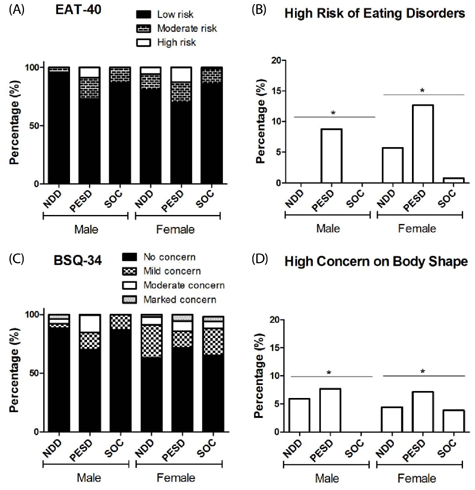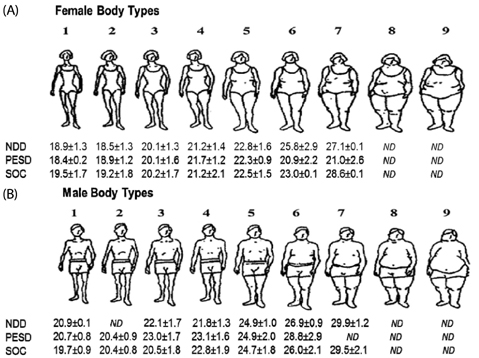Nutr Res Pract.
2014 Dec;8(6):713-718. 10.4162/nrp.2014.8.6.713.
High tendency to the substantial concern on body shape and eating disorders risk of the students majoring Nutrition or Sport Sciences
- Affiliations
-
- 1Department of Nutrition and Dietetics, Faculty of Health Sciences, Hacettepe University, 06100 Sihhiye, Ankara, Turkey. rnergiz@hacettepe.edu.tr
- 2Department of Nutrition and Dietetics, Faculty of Health Sciences, Ankara University, Ankara, Turkey.
- KMID: 2313799
- DOI: http://doi.org/10.4162/nrp.2014.8.6.713
Abstract
- BACKGROUND/OBJECTIVES
Studies have indicated that university students majoring in nutrition and dietetics or sport sciences may have more obsessions associated with eating attitudes and body shape perception compared to other disciplines i.e. social sciences. Therefore, this study aimed to assess and compare the risk of eating disorders and body shape perception.
MATERIALS/METHODS
Data was collected from 773 undergraduate students at the Departments of Nutrition and Dietetics (NDD) (n = 254), Physical Education and Sports (PESD) (n = 263), and Social Sciences (SOC) (n = 256).A socio-demographic and personal information questionnaire, Eating Attitudes Test (EAT-40), Body Shape Questionnaire (BSQ-34), Perceived Figure Rating Scale (FRS) were applied; and body weights and heights were measured.
RESULTS
Mean EAT-40 scores showed that, both male and female students of PESD had the highest scores (17.4 +/- 11.6) compared with NDD (14.3 +/- 8.3) and SOC (13.0 +/- 6.2) (P < 0.05). According to EAT-40 classification, high risk in abnormal eating behavior was more in PESD (10.7%) compared to NDD (2.9%) and SOC (0.4%) students (P < 0.05). Students of PESD, who skipped meal, had higher tendency to the risk of eating disorders (P < 0.05). In parallel, body shape perception was found to be marked with higher scores in NDD (72.0 +/- 28.7) and PESD (71.5 +/- 32.8) compared with SOC (64.2 +/- 27.5) students (P < 0.05). Considering BSQ-34 classification, high concern (moderate and marked) for body shape were more in PESD (7.4 %) compared to NDD (5.2%) and SOC (1.9%) students (P < 0.05). The body size judgement via obtained by the FRS scale were generally correlated with BMI. The Body Mass Index levels were in normal range (Mean BMI: 21.9 +/- 2.8 kg/m2) and generally consistent with FRS data.
CONCLUSIONS
Tendency to the abnormal eating behavior and substantial body shape perception were higher in PESD students who have more concern on body shape and were not well-educated about nutrition. In conclusion, substantial concern on physical appearance might affect eating behavior disorders in PESD students.
MeSH Terms
Figure
Reference
-
1. Steptoe A, Wardle J, Cui W, Bellisle F, Zotti AM, Baranyai R, Sanderman R. Trends in smoking, diet, physical exercise, and attitudes toward health in European university students from 13 countries, 1990-2000. Prev Med. 2002; 35:97–104.
Article2. World Health Organisation (CH). Global prevalence and secular trends in obesity. WHO Technical Report Series 894. Obesity: Preventing and Managing the Global Epidemic. Geneva: World Health Organisation;2000. p. 16–34.3. Korinth A, Schiess S, Westenhoefer J. Eating behaviour and eating disorders in students of nutrition sciences. Public Health Nutr. 2010; 13:32–37.
Article4. Forestell CA, Humphrey TM, Stewart SH. Is beauty in the eye of the beholder? Effects of weight and shape on attractiveness ratings of female line drawings by restrained and nonrestrained eaters. Eat Behav. 2004; 5:89–101.5. Pook M, Tuschen-Caffier B, Brähler E. Evaluation and comparison of different versions of the Body Shape Questionnaire. Psychiatry Res. 2008; 158:67–73.
Article6. Elal G, Altug A, Slade P, Tekcan A. Factor structure of the Eating Attitudes Test (EAT) in a Turkish university sample. Eat Weight Disord. 2000; 5:46–50.
Article7. Mealha V, Ferreira C, Guerra I, Ravasco P. Students of dietetics & nutrition; a high risk group for eating disorders? Nutr Hosp. 2013; 28:1558–1566.8. Cain AS, Epler AJ, Steinley D, Sher KJ. Concerns related to eating, weight, and shape: typologies and transitions in men during the college years. Int J Eat Disord. 2012; 45:768–775.
Article9. Lavender JM, De Young KP, Anderson DA. Eating Disorder Examination Questionnaire (EDE-Q): norms for undergraduate men. Eat Behav. 2010; 11:119–121.
Article10. Sanlier N, Yabanci N, Alyakut O. An evaluation of eating disorders among a group of Turkish university students. Appetite. 2008; 51:641–645.
Article11. Aşçi FH, Tüzün M, Koca C. An examination of eating attitudes and physical activity levels of Turkish university students with regard to self-presentational concern. Eat Behav. 2006; 7:362–367.
Article12. Sakamaki R, Amamoto R, Mochida Y, Shinfuku N, Toyama K. A comparative study of food habits and body shape perception of university students in Japan and Korea. Nutr J. 2005; 4:31.
Article13. Yahia N, El-Ghazale H, Achkar A, Rizk S. Dieting practices and body image perception among Lebanese university students. Asia Pac J Clin Nutr. 2011; 20:21–28.14. Amaral Alves D, Hernández Regidor N, Basabe Baraño N, Rocandio Pablo AM, Arroyo Izaga M. Body satisfaction and diet quality in female university students from the Basque Country. Endocrinol Nutr. 2012; 59:239–245.
Article15. Thomas DT, McArthur L, Corbett RW. Nutrition knowledge and attitudes of allied health and fitness students. J Allied Health. 2006; 35:e37–e58.16. Ozdoğan Y, Ozcelik AO. Evaluation of the nutrition knowledge of sports department students of universities. J Int Soc Sports Nutr. 2011; 8:11.
Article17. Gonidakis F, Sigala A, Varsou E, Papadimitriou G. A study of eating attitudes and related factors in a sample of first-year female nutrition and dietetics students of Harokopion University in Athens, Greece. Eat Weight Disord. 2009; 14:e121–e127.
Article18. Silva JD, Silva AB, de Oliveira AV, Nemer AS. Influence of the nutritional status in the risk of eating disorders among female university students of nutrition: eating patterns and nutritional status. Cien Saude Colet. 2012; 17:3399–3406.19. Garner DM, Garfinkel PE. The eating attitudes test: an index of the symptoms of anorexia nervosa. Psychol Med. 1979; 9:273–279.
Article20. Savaşır I, Erol N. Yeme tutum testi: Anoreksiya Nervoza Belirtileri İndeksi. Türk Psikoloji Dergisi. 1989; 7:19–25.21. Cooper PJ, Taylor MJ, Cooper Z, Fairburn CG. The development and validation of the body shape questionnaire. Int J Eat Disord. 1987; 6:485–494.
Article22. Akdemir A, Inandi T, Akbas D, Karaoglan Kahilogullari A, Eren M, Canpolat BI. Validity and reliability of a Turkish version of the body shape questionnaire among female high school students: preliminary examination. Eur Eat Disord Rev. 2012; 20:e114–e115.
Article23. Stunkard AJ, Sørensen T, Schulsinger F. Use of the Danish Adoption Register for the study of obesity and thinness. Res Publ Assoc Res Nerv Ment Dis. 1983; 60:115–120.24. Bays HE, Bazata DD, Fox KM, Grandy S, Gavin JR 3rd. SHIELD Study Group. Perceived body image in men and women with type 2 diabetes mellitus: correlation of body mass index with the figure rating scale. Nutr J. 2009; 8:57.
Article25. Lohmann TG, Roche AF, Martorell R. Anthropometric Standardization Reference Manual. Champaign (IL): Human Kinetics Books;1988.26. Neslişah R, Emine AY. Energy and nutrient intake and food patterns among Turkish university students. Nutr Res Pract. 2011; 5:117–123.
Article27. Nichols SD, Dookeran SS, Ragbir KK, Dalrymple N. Body image perception and the risk of unhealthy behaviours among university students. West Indian Med J. 2009; 58:465–471.28. Bulik CM, Wade TD, Heath AC, Martin NG, Stunkard AJ, Eaves LJ. Relating body mass index to figural stimuli: population-based normative data for Caucasians. Int J Obes Relat Metab Disord. 2001; 25:1517–1524.
Article29. Serifović S, Dinnel DL, Sinanović O. Body dissatisfaction: how is it related to stress and one's perception of individual and cultural ideal body? A comparison of Bosnian and American university students. Bosn J Basic Med Sci. 2005; 5:27–33.
Article30. Must A, Phillips SM, Stunkard AJ, Naumova EN. Expert opinion on body mass index percentiles for figure drawings at menarche. Int J Obes Relat Metab Disord. 2002; 26:876–879.
Article
- Full Text Links
- Actions
-
Cited
- CITED
-
- Close
- Share
- Similar articles
-
- A Study of the Relationship between the Eating Attitude Influenced by Eating DDisorder and Body Shape, Nutritional Knowledge among Female College Students in Won Ju Province
- Effects of Obesity, Body Image Dissatisfaction and Dietary Habits on the Risk of Disturbed Eating Attitudes among High School Students in Gyunggi Province, Korea
- The Weight Control-Related Attitudes, Dietary Self-Efficacy and Eating Behaviors according to the Perception of Eating Disorder and Obesity Index in Dancing Major High School Girls
- The Relationship between Eating Disorder and Self-esteem in Female College Students
- Comparative study on body shape satisfaction and body weight control between Korean and Chinese female high school students



